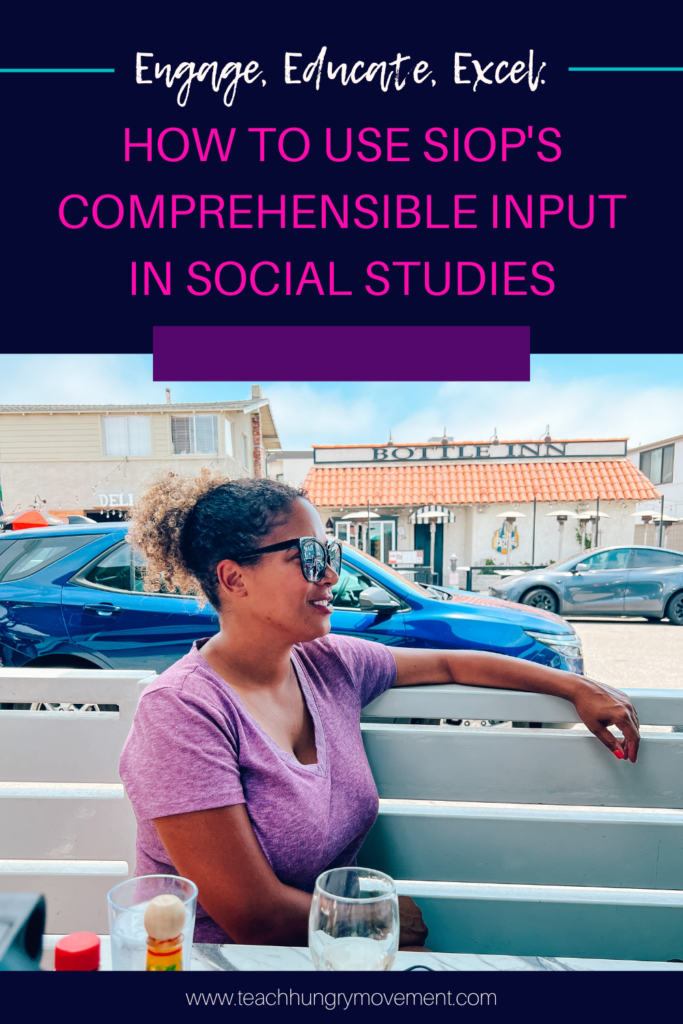You’ve made it to the third SIOP component, Comprehensible Input! (Haven’t read about the first two components? Click here for Lesson Preparation and here for Building Background). Let’s explore how this component can make social studies come alive for our ELL students. So, let’s roll up our sleeves and uncover some invaluable tips for teaching ELL students!

Before you dive into Comprehensible Input, let’s remind you what SIOP is. It’s a research-based framework created by Drs. Jana Echevarria & MaryEllen Vogt. It’s designed to support ESL students. As a matter of fact, it helps all learners.
There are 8 components of SIOP:
- Lesson preparation
- Building Background
- Comprehensible Input
- Strategies
- Interaction
- Practice & Application
- Lesson Delivery
- Review & Assessment.
Ok, so what exactly is SIOP Comprehensible Input, you ask?
It’s a vital component of the Sheltered Instruction Observation Protocol (SIOP) model. It’s designed to make content accessible and understandable for ELL students. In simple terms, it’s all about presenting information in a way they’ll understand. This helps them grasp the subject matter effectively.
Now, let’s look at some essential tips for teaching English Language Learners. Leverage the power of Comprehensible Input within the SIOP framework.
Use Clear and Concise Language:
Avoid using complex sentences or jargon that may confuse ELL students. Instead, use clear and concise language. Break down difficult concepts into simpler terms. Also, provide definitions or explanations when necessary.
Remember, simplicity is the key to comprehension!
Visual Aids and Graphic Organizers:
Incorporate plenty of visuals, such as maps, infographics, and images. This will support ELL students’ understanding of complex concepts. Use graphic organizers to help students organize their thoughts. They can also use them to make connections between ideas.
Realia and Authentic Materials:
Bring real-world objects (realia), artifacts, or authentic materials into the classroom. This will make the content more tangible and relatable. For example, display photographs, primary sources, or cultural artifacts related to historical events.
Gesture and Body Language:
Use gestures, facial expressions, and body language to enhance communication. These nonverbal cues can help convey meaning and support comprehension. This is especially effective for ELL students still developing their language skills.
Chunk Information:
Break down complex topics into bite-sized chunks. ELL students can absorb information better when it’s presented in manageable pieces. It’s especially important to do this with reading tasks.
Grab my free lesson bundle for ideas for supporting the ELLs in your social studies classes!
Model and Demonstrate:
Show, don’t just tell! ELL students benefit from demonstrations and real-life examples. So be bold to illustrate abstract concepts.
Encourage Interaction:
Create opportunities for ELL students to interact with their peers and the teacher. Group discussions, pair work, and collaborative activities are perfect for practicing language skills!
You now know the basics of SIOP’s Comprehensible Input! So let’s explore some engaging lesson ideas for U.S. History, World History, and Civics. These are designed to leverage the power of Comprehensible Input for ELL students:
U.S. History:
Idea 1: Historical Picture Analysis
- Engage ELL students with historical images of a particular event or time period.
- Guide them through analyzing the pictures and discussing the people, objects, and actions.
- Use sentence frames or graphic organizers to help students express their observations & interpretations.
This activity promotes language development, critical thinking, and content comprehension.
Idea 2: Time-Traveling News Broadcast
- Organize a time-traveling news broadcast where students report on key historical events.
- Provide ELL students with simple scripts and visuals to support their presentations.
This interactive activity brings history to life! And it helps ELL students better understand the significance of past events.
World History:
Idea 1: Cultural Comparisons
- Encourage ELL students to explore different cultures & civilizations by comparing them to theirs.
- Assign each student/small group a specific culture or civilization from World History.
- Provide them with resources like videos, articles, or interviews.
- Have students identify similarities & differences between their culture and the one they’re studying.
- Engage them in discussions & provide sentence stems or vocabulary support to ease comprehension.
Idea 2: Cultural Exchange Gallery Walk
- Transform your classroom into a cultural exchange gallery!
- Assign each student/small group to a different civilization or time period.
- Have them create posters about their civilization’s cultural, social, and political aspects.
ELL students can use simple sentences to explain their posters to their peers. This makes it a fun and immersive learning experience!
Civics:
Idea 1: Current Events News Report
- Help ELL students connect civics by having them research & present reports on current events.
- Assign each student/small group a current event related to a civic issue, such as:
- immigration,
- voting rights,
- climate change
- Provide ELL students with scaffolds to support their language production. This could include:
- sentence frames
- graphic organizers
- Assign each student/small group a current event related to a civic issue, such as:
This activity promotes language development, critical analysis, and civic engagement.
Idea 2: Government Jigsaw Puzzle
- Turn to learn about different forms of government into a jigsaw puzzle activity!
- Divide the class into small groups. Each assigned a specific type of government (e.g., democracy, monarchy, or communism).
- Provide ELL students with a simplified summary of their assigned system.
- In their groups, they’ll piece together the puzzle of how different governments function.
Now that you’ve explored some engaging lessons, let’s reiterate the importance of SIOP Comprehensible Input. Comprehensible Input empowers you to create lessons that ensure ELLs can understand the content.
Don’t forget to Grab my 5 Foolproof Strategies to Support ELs in Your Social Studies Classes lesson bundle. It’s chock full of some of the strategies discussed in this post.
+ show Comments
- Hide Comments
add a comment